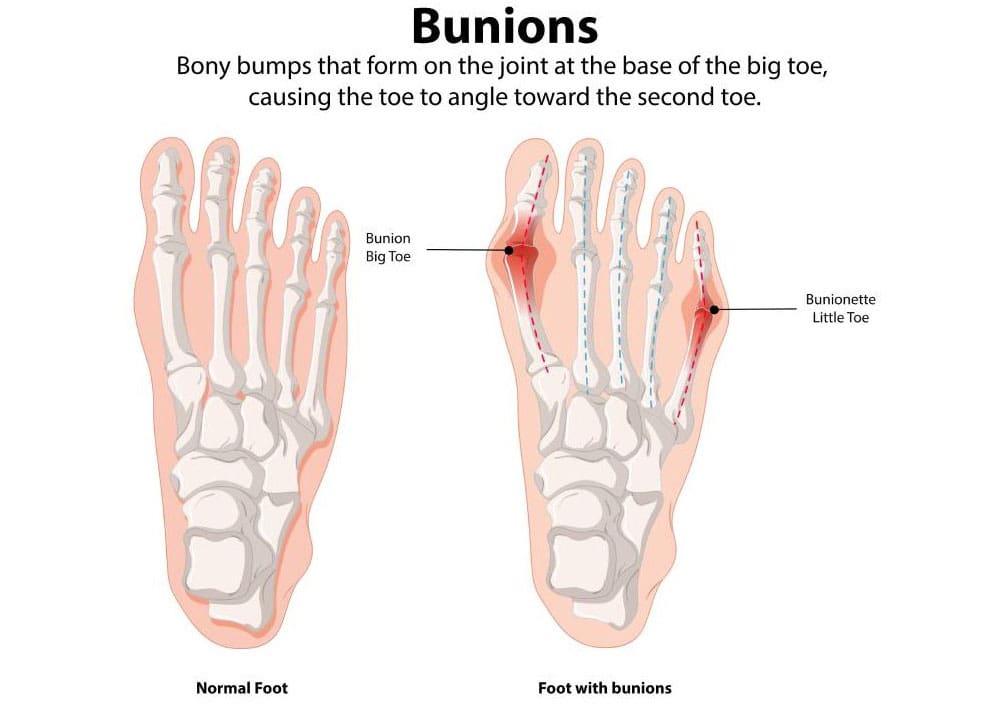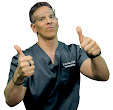How can one effectively manage the early signs of bunions?

Bunions
Visual Signs of Early Symptoms
- Redness
- Skin that is darker and swollen
- Skin that has gotten thicker and harder
- There is a bony bump
- A bump where the big toe goes toward the second toe or under it
- Corns and calluses
Physical Signs Early On
- Pain in the foot and big toe
- Walking or wearing tight, narrow-toed shoes aggravates this ache.
- Decreased movement of the big toe
- Tenderness
- Inflammation
- Swelling
- Stiffness
- Heat
Stages
- Prolonged, excruciating pain in the MTP joint, as well as on the sides and bottom of your foot
- Bursitis, which results in the formation of a fluid-filled sac near the base of your big toe
- Your big toe may even bend over and cross over your second toe.
- Overgrowth of bone on the side of your big toe
- Not being able to wear your normal shoes
- Having trouble walking
- When you have hammer toe abnormalities, your second, third, or fourth toes bend upward in the middle, like a claw or hammer.
- Hallux rigidus is the name for big toe arthritis.
Stop the Progress
- Steer clear of high heels and poorly fitting shoes.
- Putting on wide, cozy, low-heeled shoes with soft soles or orthopaedic footwear
- By putting spacers between your toes, you can avoid chafing and rubbing.
- Using over-the-counter (OTC) pads composed of foam, silicone, or felt to cover the bunion
- To enhance joint alignment, stretch your calf muscles.
Pain Control
Bunion discomfort can be reduced using ice packs and non-steroidal anti-inflammatory medications (NSAIDs), such as Advil or Motrin (ibuprofen). Injections of Botox into the forefoot muscles may also alleviate discomfort, according to studies. (Hurn, S. E., et al., 2022)Early-stage nonsurgical treatment
Orthotics, or foot orthoses
- Orthoses, sometimes referred to as foot orthoses, are specially made inserts that reduce pain and avoid chafing in the bunions.
Splints
- Bunion splints are orthotic devices that can help straighten your toes. They are often worn overnight.
- (Aebischer, A. S., & Duff, S. 2020)
Physical Therapy
- You can get assistance from a physical therapist by doing exercises that will help your joints and feet align better. To relieve discomfort, they can also use manual therapy. (Hurn, S. E., et al., 2022)
Podiatrist
Chiropractic Treatment
A chiropractor and nurse practitioner can address bunions through complementary approaches, focusing on pain relief, improved foot function, and slowing progression. Here’s how each can help:
Chiropractor:
- Adjustments and Mobilization: Chiropractors can perform adjustments to the foot and ankle to improve joint alignment and mobility, reducing stress on the bunion (big toe joint). This may alleviate pain and enhance foot function.
- Soft Tissue Therapy: Techniques like massage or myofascial release can reduce tension in foot muscles and tissues around the bunion, improving flexibility and reducing discomfort.
- Custom Orthotics: Some chiropractors provide or recommend custom shoe inserts to support proper foot alignment, redistribute pressure, and prevent worsening of the bunion.
- Exercise and Stretching: They may prescribe specific exercises to strengthen foot muscles, improve toe mobility, and promote proper gait, which can help manage symptoms.
- Lifestyle Advice: Chiropractors often guide patients on footwear choices (e.g., wide-toed, supportive shoes) and activities to avoid aggravating the bunion.
Nurse Practitioner:
- Medical Assessment: A nurse practitioner (NP) can evaluate the bunion’s severity, check for underlying conditions (e.g., arthritis or gout), and assess for complications like bursitis or infection.
- Pain Management: NPs can prescribe or recommend medications, such as nonsteroidal anti-inflammatory drugs (NSAIDs), like ibuprofen, to reduce pain and inflammation.
- Referrals: If the bunion is severe or progressive, an NP can refer the patient to a podiatrist or orthopedic surgeon for further evaluation, imaging (e.g., X-rays), or potential surgical options.
- Wound Care: If the bunion causes skin irritation, blisters, or open sores, an NP can provide or recommend appropriate wound care to prevent infection.
- Patient Education: NPs can educate on bunion management, including proper footwear, weight management to reduce foot pressure, and when to seek specialist care.
Collaborative Care:
- Together, a chiropractor and NP can create a holistic plan. For example, the chiropractor addresses biomechanical issues and pain through non-invasive methods, while the NP manages medical aspects, such as inflammation or complications.
- They may recommend conservative treatments like padding, taping, or splinting the bunion to reduce pressure and pain, alongside monitoring for signs that surgery might be needed.
Limitations:
- Neither can a surgeon surgically correct a bunion, which may be necessary for severe cases. A podiatrist or orthopedic surgeon is typically required for surgical intervention.
- Effectiveness depends on bunion severity—mild cases respond better to conservative care than advanced deformities.
Practical Steps:
- Wear wide-toed, low-heeled shoes to reduce pressure.
- Use over-the-counter bunion pads or toe spacers for comfort.
- Apply ice to the area to reduce swelling after activity.
- Follow prescribed exercises or stretches to maintain foot mobility.
If symptoms persist or worsen (e.g., severe pain, difficulty walking), consult a podiatrist for specialized care. Always ensure the chiropractor and NP are licensed and coordinate care if needed.
Injury Medical Chiropractic and Functional Medicine Clinic
Enhance Your Performance with Functional Foot Orthotics
The information herein is not intended to replace a one-on-one relationship with a qualified healthcare professional or licensed physician and is not medical advice. We encourage you to make healthcare decisions based on your research and partnership with a qualified healthcare professional. Our information scope is limited to chiropractic, musculoskeletal, and physical medicine, as well as wellness, sensitive health issues, and functional medicine articles, topics, and discussions. We provide and present clinical collaboration with specialists from various disciplines. Each specialist is governed by their professional scope of practice and the jurisdiction in which they are licensed. We utilize functional health and wellness protocols to treat and support care for injuries or disorders affecting the musculoskeletal system. Our videos, posts, topics, subjects, and insights cover clinical matters, issues, and topics that relate to and directly or indirectly support our clinical scope of practice. Our office has made a reasonable attempt to provide supportive citations and identified relevant research studies that support our posts. We provide copies of supporting research studies upon request to regulatory boards and the public.
We understand that we cover matters that require an additional explanation of how they may assist in a particular care plan or treatment protocol. To discuss the subject matter above further, please contact Dr. Alex Jimenez or us at 915-50-0900.
Dr. Alex Jimenez, DC, MSACP, CCST, IFMCP*, CIFM*, ATN*
Email: coach@elpasofunctionalmedicine.com
Licensed in: Texas & New Mexico*




